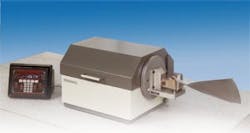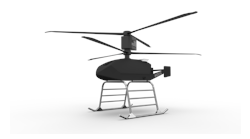The GE Transportation Aircraft Engines CF34 Series of jet engines represent the genre for propulsion in the regional jet market, particularly in the 50- to 70-seat passenger class of airframes. Balancing requirements are established by the engine manufacturer to ensure vibration levels aren’t exceeded. Some of the benefits of minimizing vibration include reduction of friction, ensuring bearing life, reduction of the potential for low cycle fatigue, and achieving efficiency in operation. The engine manufacturer establishes all overhaul parameters including balancing speed, unbalance correction locations, unbalance correction methods, and unbalance tolerances for each rotor assembly.
Typically, jet engine rotor balancing incorporates multiple processes including blade sorting and distribution, static balancing, and dynamic balancing. Blade sorting and distribution can be accomplished through mass weighing or moment weighing, using an appropriate scale suitable for the intended task. Static balancing involves unbalance correction in a single plane specified by the engine manufacturer. Dynamic balancing typically applies to an assembly where unbalance is corrected in two planes.
Unbalance correction can be accomplished by redistribution of mass, addition of mass, or removal of mass. Each balancing task uses one of these methods to achieve the manufacturer-specified rotor unbalance tolerance.
Anatomy of the engine
The CF34-3 jet engine is a dual-spool design. The engine includes four major rotor modules: fan with forward shaft, compressor rotor assembly, high-pressure turbine rotor, and low-pressure turbine rotor.
The high-pressure turbine rotor is directly coupled to the compressor rotor assembly and forms the core engine (also referred to as the high-pressure spool). The fan with forward shaft is connected to the low-pressure turbine rotor via the fan drive shaft and comprises the low-pressure spool. In service, each of the two spools spin at a different speed to achieve performance parameters established by the engine manufacturer. Because of the different operating speeds, weights, effective radii, moments of inertia, and resultant centrifugal forces these spools are subjected to, the engine manufacturer specifies a variety of methods to reduce unbalance to a residual level that limits vibration in service.
Mass distribution, moment weighing, static balancing, and dynamic balancing processes are incorporated in the overhaul requirements for CF34-3 rotor assemblies. An overview of each rotor balancing process will provide the reader with an overview of requirements necessary for establishing a CF34-3 jet engine overhaul facility.
Fan with forward shaft
The single-stage fan with forward shaft is statically balanced on a horizontal balancing machine using a build and balance process. The unbladed fan disk with forward fan shaft unbalance is measured and recorded on the balancing machine. Fan blade retainers and spinner are then installed onto the assembly and unbalance is again measured and corrected using mass distribution of the blade retainer pins. Fan blades are moment weighed and distributed about the fan disk to compensate for the residual rotor unbalance of the unbladed fan rotor assembly. Residual rotor unbalance can be incorporated into the fan blade distribution solution. Finally, the fully assembled fan rotor with fan blades is check balanced.
The fan drive shaft is balanced in two planes by material removal using a fixture on the balancing machine. CF34-3 fan drive shaft balancing is not often required unless the fan drive shaft is being replaced or otherwise subjected to an OEM-approved repair.
Compressor rotor assembly
The CF34-3 compressor rotor assembly is comprised of three major elements including the:
- 1-2 spool assembly
- 3-9 spool assembly
- 10-14 spool assembly
The CF34-3A compressor rotor incorporates loose blades in Stages 1 and 2. Stage 1 and Stage 2 compressor blades are mass weighed and distributed about the compressor 1-2 spool to optimize mass distribution. The CF34-3B compressor rotor incorporates an integrally bladed Stage 1 rotor which is commonly referred to as a ‘Blisk.’
The compressor 1-2 spool assembly is dynamically balanced in two planes using a stub shaft tool that serves as a bearing journal. For the CF34-3A, unbalance correction can be accomplished by blade swapping Stage 1 and Stage 2 compressor blades. Only the loose Stage 2 compressor blades can be mass weighed and distributed on a CF34-3B compressor 1-2 spool.
The compressor Stage 10-14 spool assembly is dynamically balanced in two planes using a stub shaft tool that serves as a bearing journal. This spool features annular dovetail grooves to retain Stage 10 through Stage 14 compressor blades. Unbalance correction can be accomplished by shifting blades at each stage of the spool. Locking tabs secure the blades from shifting about in their dovetail groove.
After completing the 1-2 spool and 10-14 spool balancing tasks, the major compressor components including the 1-2 spool, 3-9 spool, and 10-14 spool are assembled together to complete the compressor rotor. The compressor rotor is then dynamically balanced in two planes to complete the CF34-3 compressor assembly and balancing tasks. Final unbalance correction in forward and aft correction planes is accomplished by addition of mass.
High-pressure rotor
The CF34-3 high-pressure turbine rotor assembly consists of two stages. Schenck recommends Stage 1 and Stage 2 turbine blades be mass weighed and distributed about each disk to reduce the initial unbalance of the high-pressure turbine rotor assembly. Unbalance is corrected at Stage 1 by the addition of cup washers secured by bolts. Unbalance is corrected at Stage 2 by the addition of small unbalance correction masses under the Stage 2 turbine blade roots. These correction masses are axially retained by a rotating seal plate on the aft face of the Stage 2 disk.
Low-pressure rotor
The CF34-3 low-pressure turbine rotor incorporates four stages. The GE Transportation Aircraft Engines overhaul manual requires each stage be statically balanced. An alternative procedure permits each stage of the low-pressure turbine rotor to be optimized for unbalance using a computer-based solution. Schenck recommends Stage 1 through Stage 4 low-pressure turbine blades be mass weighed and distributed using a mass weighing and blade distribution system such as Schenck’s BLADIS online system. Once the blade sets are optimized, the low-pressure turbine rotor is assembled into a bladed rotor and dynamically balanced in two planes. Unbalance correction to reach the unbalance tolerance in each correction plane of the rotor assembly is accomplished by the addition of mass.
This article has been an introduction to balancing requirements for the CF34-3 jet engine. One should always refer to the engine manufacturer’s maintenance manual for specific instruction prior to attempting any engine overhaul task. Mechanics should be specifically trained and certified for completing the balancing tasks referenced in this article.


